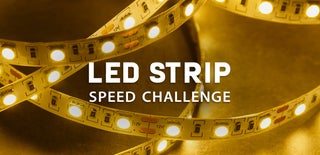Introduction: Automatic Closet LED Light
This is the entry closet in our home, and you can see by the pictures its rather dark even in the middle of the day. It was really annoying in the early morning when its still dark outside. (The hall and other overhead lights in the area didn't help.) We had to use flashlights just to find our shoes and coats. Not anymore!
You can find your shoes and get a tan at the same time!
(Pictures with door open and no light - I disabled the light just to show how dark it is inside. The light is automatically turned on whenever the door is opened.)
I'm catching up on documenting some old projects. This one is a few years old and as such I won't be going into the level of detail like I do on my new projects (mostly because I don't have any pictures from the build). I wanted to complete this one especially, so I could enter it into the LED contest before the entry deadline.
This project as shown works with standard 120V AC house current. If you're not comfortable working with that consider using a different style of light and install the switch on the DC voltage wiring (all instructions given here still apply if done on DC). Only issue with that is the transformer will always be on and wasting some (not much) electricity. My setup only uses electricity when the light is activated by opening the closet door.
Supplies
- 120V AC Strip LED Lights
- Push Button Momentary Switch (Normally ON, momentarily OFF)
- I know I got the switch at Ace Hardware but couldn't find the exact same one online. Its similar to this one though. (I would have used this one given the choice.)
- I know I got the switch at Ace Hardware but couldn't find the exact same one online. Its similar to this one though. (I would have used this one given the choice.)
- Normal household tools
- Grounded plug with at least a foot of wire
- Wire Nuts
- 2 Part Putty Epoxy
Step 1: Electricity
To be honest I don't remember if this outlet was already there or if I added it at some point. (We've been in the same house for over 20 years). Either way, its obviously key to the project. There's plenty of videos out there to add an outlet if you need to do that step, so I won't cover it here.
Step 2: Lights
I got a bunch of these on sale from Home Depot a few years back. I replaced all the fluorescent shop lights in the garage and still had several left. So one was sacrificed for this project.
I basically just took it completely apart, removed the LED strips (4 24" long strips) and the transformer. Threw out the diffuser and frame.
Step 3: Switch Placement
I'm not particularly pleased with how this part ended up. As you can see I simply cut back the door's trim molding, used the 2 part putty epoxy to secure the switch into place (as well as electrically insulate the exposed terminals on the backside of the switch).
Problem was; If you depress the plunger on the switch it does not go deep enough to be flush with the outer surface of the switch, so the first attempt resulted in the door not being able to close. Duh! Should have tested the switch beforehand. I had to tear it out, and recess the switch deeper. Which makes it look rather bad. Always had intended to come back and put a filler plate around it to make it look less "Jack-Leg" (as my wife calls shoddy work.) Definitely an example of form NOT following function in this case, but sometimes good enough is good enough.
Step 4: Wiring
As mentioned earlier, I'm not going into full detail on this part. Basically you just use the two terminals on the switch to sever the electrical circuit. The switch can be placed on the hot lead or neutral, it doesn't matter. (Same goes for a DC setup, either the positive or negative side can be the side that you wire into the switch.)
The grounded plug is needed at this point since the Home Depot lights are meant to be hardwired and as such no plug is supplied with them. You can get short extension plugs with the wires already exposed for projects just like this. I usually have plenty of them laying around from old dead appliances or computers.
CAUTION: 120VAC is dangerous. Proceed at your own risk.
Disclaimer:
Your safety is your own responsibility, including proper use of equipment and safety gear, and determining whether you have adequate skill and experience. Power tools, electricity, and other resources used for this or similar projects can be dangerous, unless used properly and with adequate precautions, including safety gear. If you are a younger person or are inexperienced with electricity or electrical devices, ask for help from a parent, teacher or a licensed professional.
Step 5: LED Strip Placement
For my setup; I put two of the four strips on the left side of the door, simply screwed into the molding with short wood screws. The other two are on the right side at the same level from the ground. All in all, its WAY too bright. At some point I may pull off one strip from each side to use on another project, but for now its been fine.
(Picture above is looking from inside the closet outwards.)
Thanks for taking the time to read through my Instructable. Sorry for the lack of detail and imagery. If anyone has questions please feel free to message me. I try and answer every request and comment I get. Thanks Again.

Participated in the
LED Strip Speed Challenge











